The 12 Best AI Tools for Digital Marketing in 2025
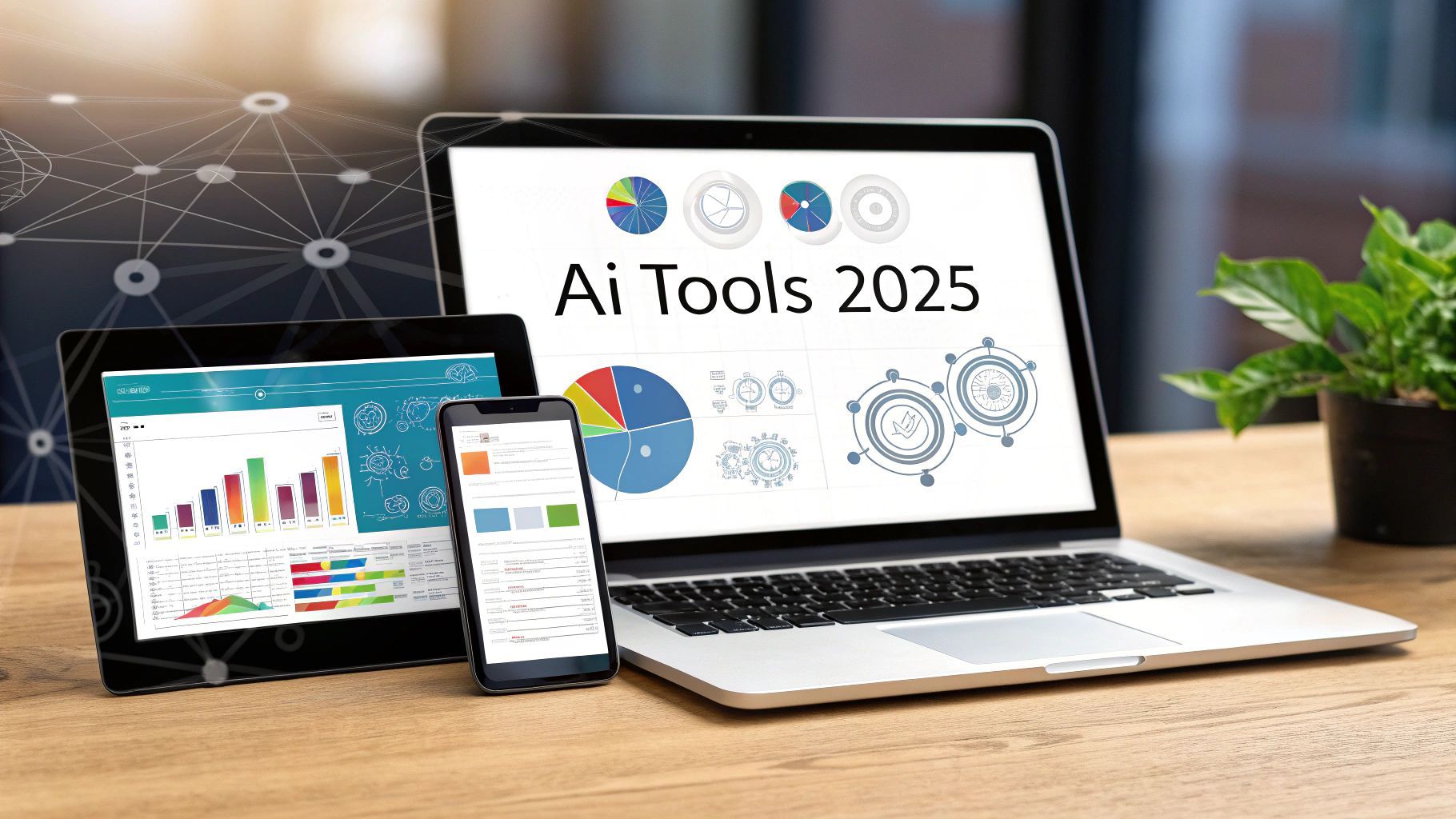


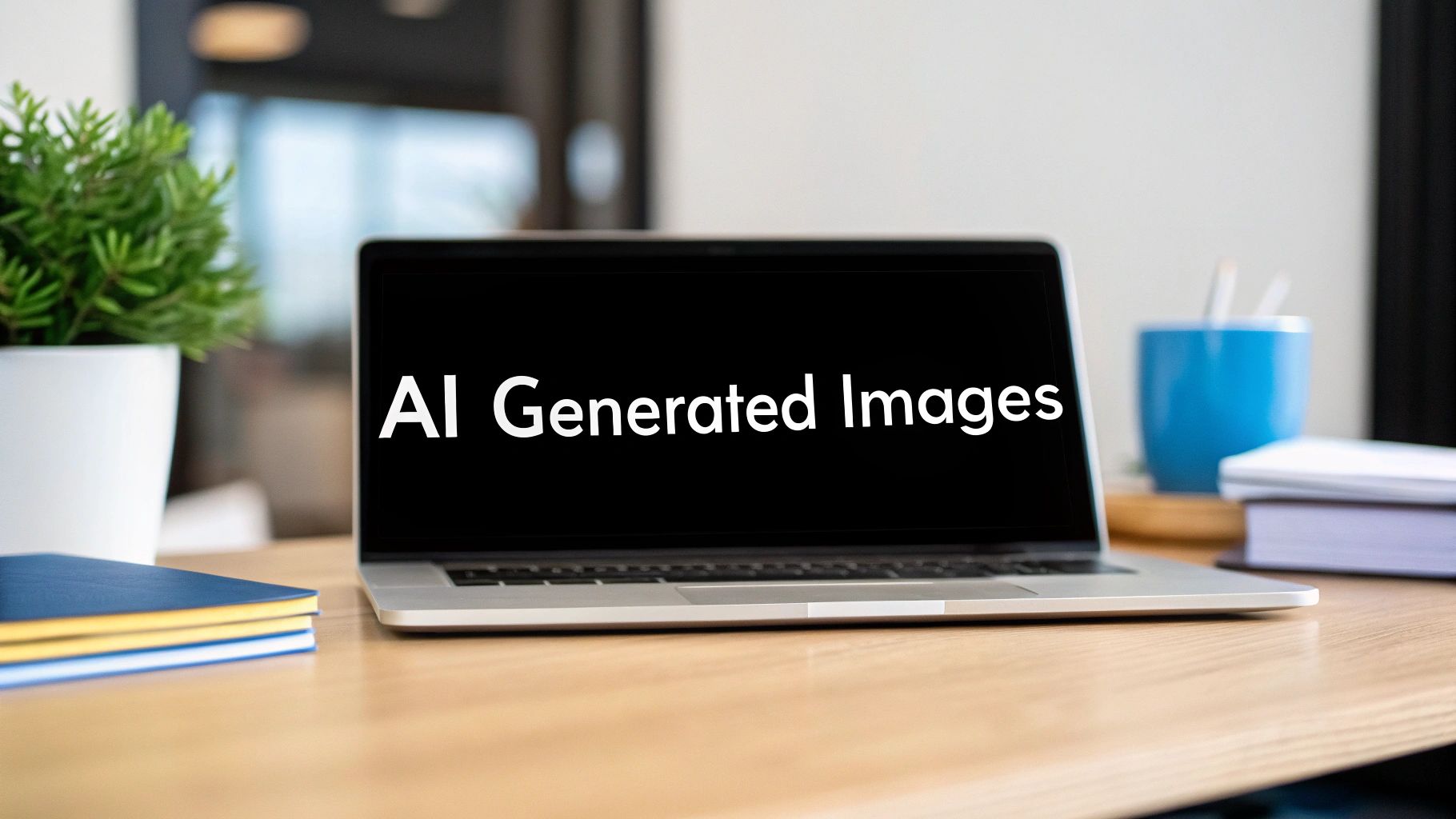
Learn to create AI generated images that get results. This guide covers prompt engineering, advanced techniques, and business uses for stunning visuals.
So, you want to make some wild, wacky, or wonderful images with AI but have no clue where to begin? It's way easier than it looks. You just type what you're thinking, and a smart tool like SendFame’s generator whips up a completely unique picture. It’s like having a direct line from your brain to the screen, no artistic talent required.
Welcome to the rabbit hole of AI art. If you've ever had a brilliant idea for an image stuck in your head, this is your chance to finally set it free. We're going to ditch the complicated jargon and jump right into the good stuff: how to turn your thoughts into eye-popping visuals. Seriously, you don't need to be a digital Picasso to make something awesome.
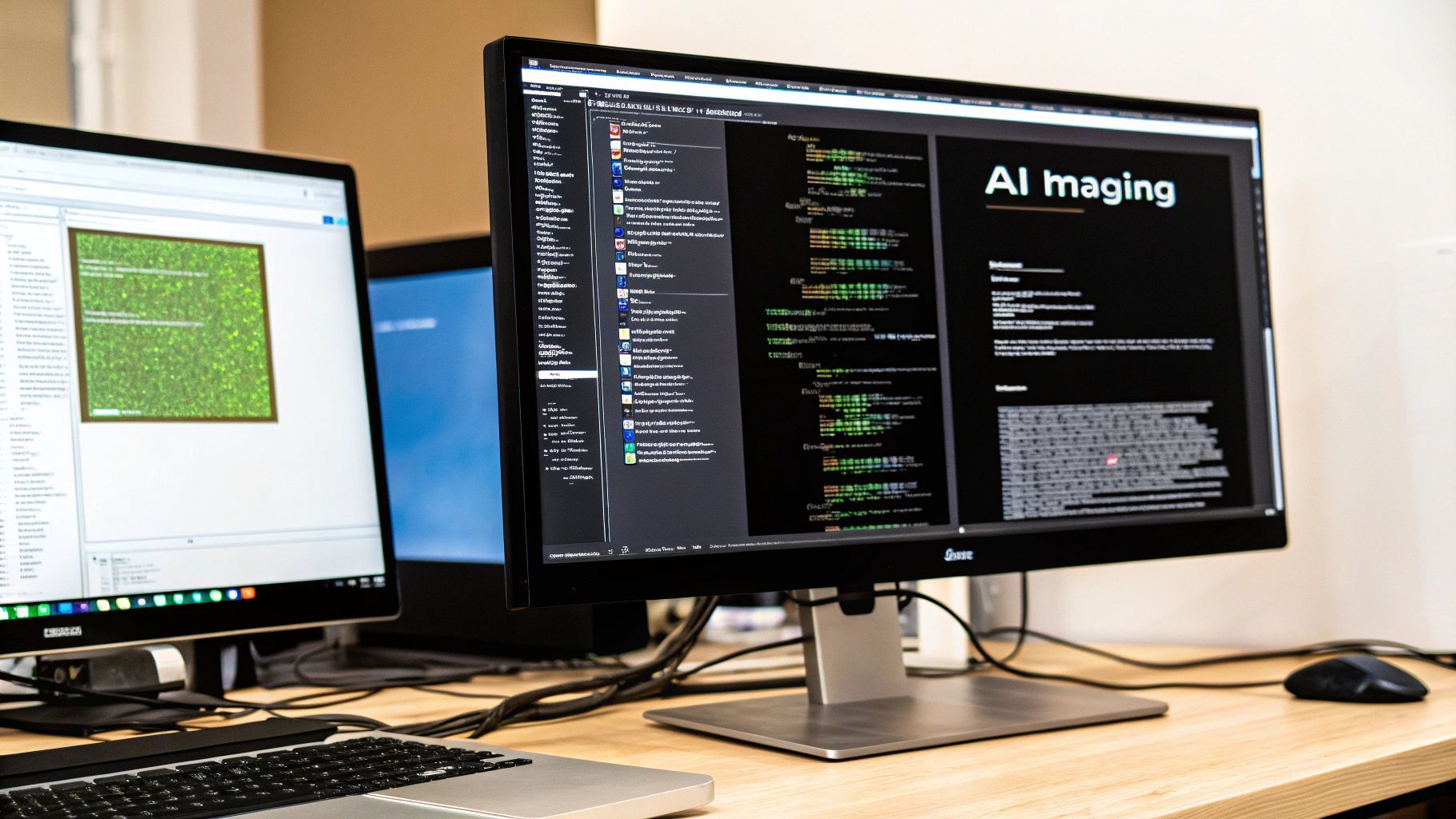
This isn't just some passing fad; it's a full-blown creative revolution. Marketing folks are spinning up ad concepts in minutes, and digital artists are charting new territories. The whole thing has exploded because it’s fast and anyone can do it. A concept that used to take a skilled designer hours can now be visualized in seconds.
The speed at which this tech has caught on is just mind-boggling. The AI image generator market, valued at about USD 418.5 million, is expected to skyrocket to USD 2.63 billion by 2035. That insane growth is all thanks to smarter AI models that can now create images with shocking realism and artistic style.
This isn't just a tech trend; it's changing the whole game for visual content. For creators and businesses, this means:
A Bottomless Well of Ideas: You can instantly mock up logos, social media graphics, or website banners without digging through the same old stock photos everyone else uses. Lightning-Fast Mockups: Got a few different visual ideas for a project? Test them all out in minutes to see what sticks. Truly Custom Visuals: Generate images that perfectly capture your brand’s vibe or the specific mood of a marketing campaign.
The real beauty of AI image generation isn't just about making pretty pictures. It's about demolishing the wall between your imagination and a finished product. Think of it as a creative partner that helps you explore ideas you didn't even know you had.
This tech isn't coming for artists' jobs. Far from it. It’s a powerful new paintbrush in the creative arsenal, just like Photoshop was a few decades ago. If you want to dig deeper into this partnership, check out this great read on how AI can enhance human creativity.
Ultimately, learning to generate images with AI is like unlocking a new superpower. You're about to discover a creative side you never knew existed. Let's get started.
Let's get one thing straight: the real magic behind stunning AI images isn't some secret button or complicated code. It's all about the words you use. Seriously. Think of yourself as a director and the prompt as your script. A lazy script gets you a lazy performance. A brilliant script? That's when the AI, your star actor, really shines. This whole game is called prompt engineering.
Tossing a vague instruction at the AI is a recipe for weird, uninspired results. Sure, "a dog" will get you a picture of a dog, but it'll be the most generic, clip-art-looking dog you've ever seen. But when you get specific, you unlock what this technology can really do. You can pull images straight out of your imagination.
Getting the best results is like mixing a good cocktail. You need the right ingredients in the right proportions. It's less about flowery language and more about giving the AI a crystal-clear checklist to follow. Let's break down what turns a weak prompt into a work of art.
A killer prompt usually layers a few key elements:
Subject: Who or what is the star of the show? Don't just say "a woman." Try "an elegant elderly woman with silver hair and a mischievous smile." Style: What vibe are you going for? This is where you can go wild. Think "in the style of Van Gogh," "hyperrealistic photo," or "90s anime concept art." Lighting: This changes everything. Words like "cinematic lighting," "soft morning glow," or "dramatic neon noir" completely dictate the mood. Composition: How is the scene framed? Use photography terms like "low-angle shot," "wide-angle view," or "shallow depth of field" to be the virtual cinematographer. Mood: What do you want people to feel? Words like "serene," "chaotic," "mysterious," or "joyful" act as your emotional guide.
By stacking these details, you're not just giving an order; you're building a world for the AI to render.
As you can see, the SendFame AI Image Generator interface is built to help you think through these elements, even giving you a spot for those all-important negative prompts.
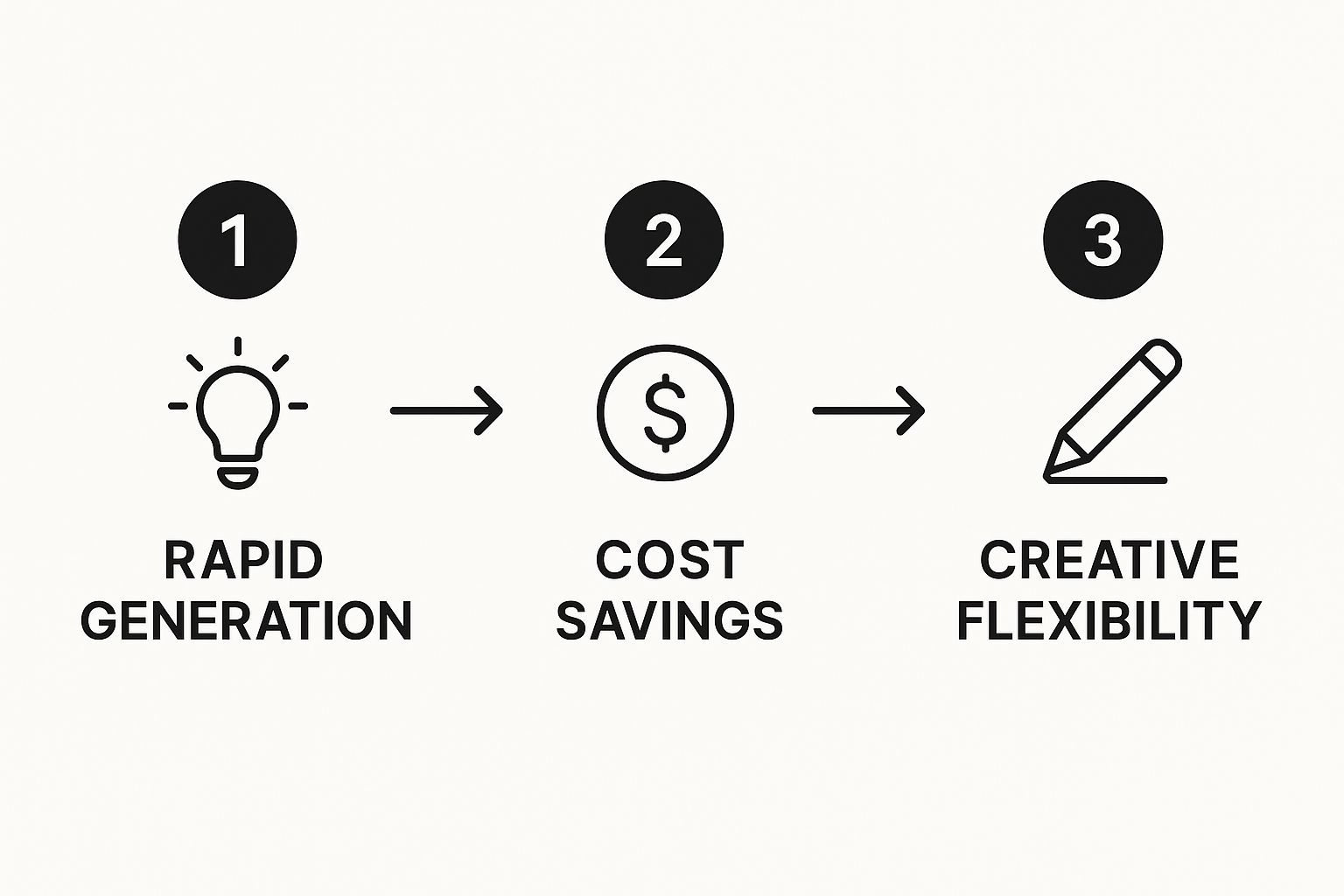
To really see the difference, let's look at how adding layers of detail completely transforms a simple idea. It's the difference between a quick sketch and a finished masterpiece.
| Element | Simple Prompt ('a cat') | Detailed Prompt ('a photorealistic siamese cat sleeping on a velvet cushion, soft morning light, detailed fur, shallow depth of field') |
|---|---|---|
| Subject | A generic cat, any breed, any pose. | A specific breed (Siamese) in a specific action (sleeping on a cushion). |
| Style | Default AI style, likely cartoony or illustrative. | Hyper-specific style: photorealistic with an emphasis on texture (detailed fur). |
| Lighting | Flat, uninspired, default lighting. | Moody and atmospheric: soft morning light. |
| Composition | Centered, boring, no depth. | Professional photography: shallow depth of field to focus on the subject. |
This table shows it's not about adding more words for the sake of it; it's about adding the right words that provide clear, actionable direction.
Sometimes, what you don't want is just as important as what you do. Welcome to the world of negative prompts. AI models can have funny little quirks, like giving people six fingers or creating melty, distorted faces in the background. Negative prompts are your way of saying, "Hey, none of that, please."
Think of negative prompts as your quality control filter. They're how you tell the AI to avoid the weird stuff—the bizarre artifacts and common glitches—to make sure the final image is clean, professional, and exactly what you envisioned.
Let's say you're generating a portrait. To dodge the most common AI weirdness, you could add a negative prompt like: extra fingers, deformed hands, blurry, bad anatomy, watermark, text, ugly. This one simple phrase can work wonders, cleaning up your image instantly. If you want to dive deeper, you can learn how to generate AI images from text with our complete guide.
It's like putting up guardrails on a bowling lane. You're just stopping the ball from ending up in the gutter.
Without a Negative Prompt: Your "photorealistic portrait" might come out with that slightly plastic-y, uncanny valley skin texture. With a Negative Prompt: By adding cartoon, 3d render, plastic look, you force the AI to steer clear of anything that looks fake, pushing it toward true photorealism.
Getting good at both positive and negative prompts is how you become a true prompt whisperer. It’s a fun, experimental process that gets more intuitive the more you do it. Before you know it, you'll be pulling incredible images right out of your head.
Theory is great, but let's be honest—the real fun is in making stuff. So, let’s get our hands dirty and create an AI-generated image from the ground up. We’re going to tackle a super common task: designing a slick, futuristic cityscape header for a blog post.
Think of this as a live creative session. We'll start simple, see what the AI cooks up, and then refine it together. You'll see my exact thought process, the tweaks I make, and probably a few happy accidents along the way. This is how it works in the real world.
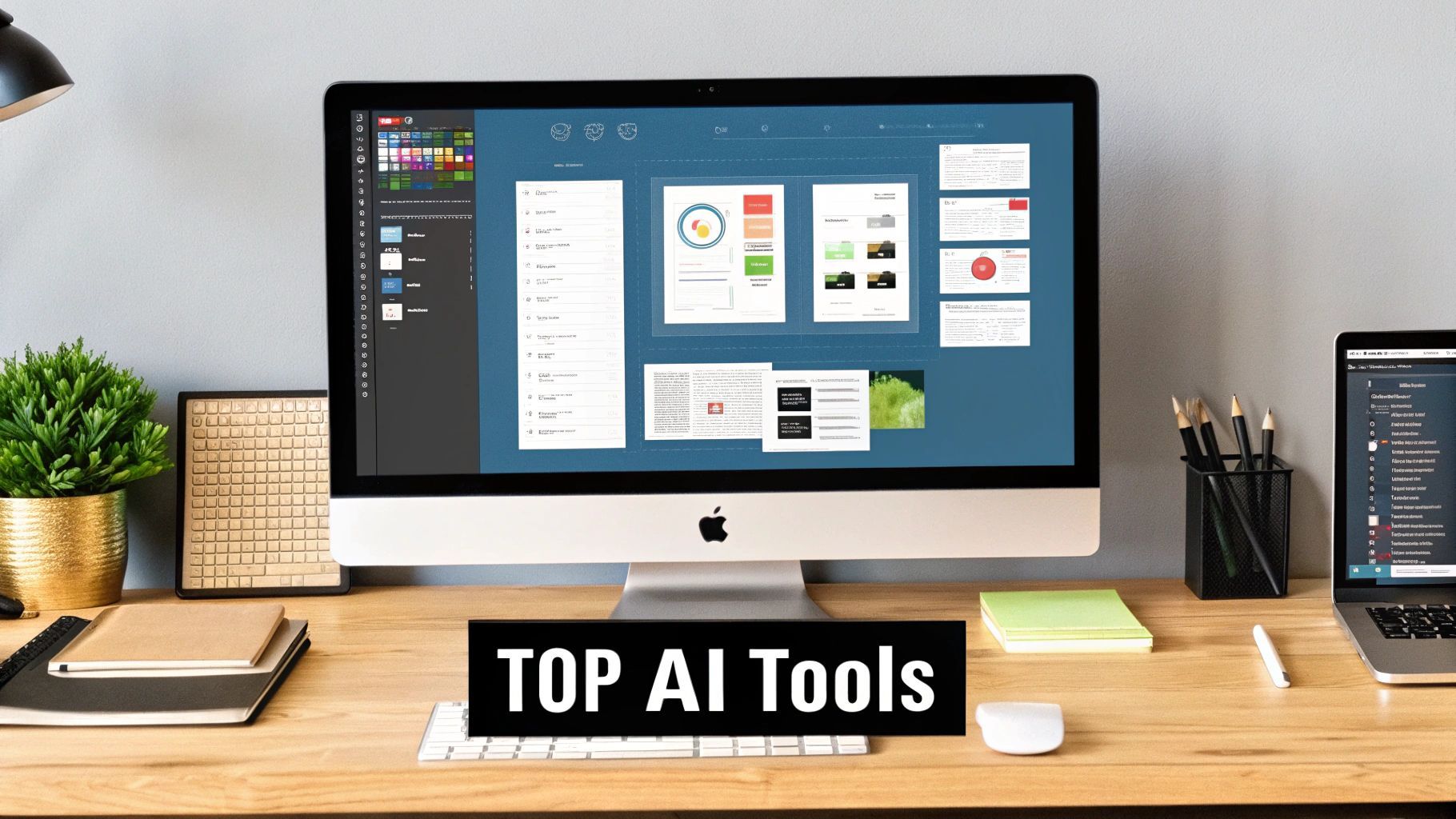
Let's kick things off with a super basic prompt. This is usually where everyone begins, and it’s a fantastic way to gauge the AI’s default "imagination."
My first swing in SendFame is just two words:futuristic cityscape
The results? They’re… okay. I mean, they're definitely futuristic cities, but they have zero personality. They feel generic. It’s like asking a chef for "food"—you'll get something to eat, but it won’t be a dish you remember. This is our baseline, and now we get to play the artist and add the spice.
The sheer speed of this technology has caused a massive explosion in visual content. By August 2023, an estimated 15.5 billion AI-generated images had been created, with around 34 million new ones popping up every single day. Platforms like OpenAI’s DALL-E, often paired with ChatGPT, have pulled in over 3 million users who crank out more than 4 million images daily, completely shaking up creative industries. If you want to dive deeper, you can learn more about the AI image generator market dynamics and see just how big this wave is.
Alright, that generic city needs a makeover. I want something with a specific vibe—a moody, rain-slicked metropolis practically dripping with neon. This is where we start layering in stylistic keywords to give the AI some real direction.
My new-and-improved prompt becomes:futuristic cityscape, cyberpunk aesthetic, neon glow, rainy streets, reflections on the wet pavement, moody atmosphere
Whoa. The whole scene just transformed. The AI gets it now. The boring buildings are replaced by massive structures plastered with glowing ads, and the streets have that slick, reflective look straight out of a movie like Blade Runner. We didn't just ask for a city; we asked for a story.
This is the fundamental loop of creating with AI: Generate, Analyze, Refine. You toss out a simple idea, see what comes back, and then add specific details to nudge the result closer to your vision. It’s more of a conversation than a command.
The image is looking a million times better, but the composition still feels a little… flat. It’s like the picture was snapped by a tourist standing on the sidewalk. Let’s grab the virtual camera and inject some drama into the shot.
Photographic terms are your secret weapon here. Using them tells the AI not just what to create, but how to frame it.
I’m just going to add a camera angle to my prompt:futuristic cityscape, **low-angle shot**, cyberpunk aesthetic, neon glow, rainy streets, reflections on the wet pavement, moody atmosphere
That single addition—low-angle shot—makes a world of difference. Suddenly, the buildings are towering over you, creating an incredible sense of scale and awe. The perspective is instantly more dynamic, more cinematic. We're no longer just looking at the city; we're in it, craning our necks to see the top.
Here are a few other camera tricks to keep in your back pocket:
Drone shot: Perfect for a top-down, bird's-eye view. Wide-angle lens: Captures a much broader scene, awesome for landscapes. Telephoto lens: Squashes the background, making distant things feel closer. Close-up shot: Zooms in on a specific detail to create intimacy.
We are so close. The image has the right style, mood, and composition. But since this is destined to be a blog header, the shape is all wrong. Most AI tools default to a square (1:1) aspect ratio, which just won’t cut it for a wide banner.
Inside SendFame, I can easily tweak the aspect ratio. For a blog header, something like 16:9 (widescreen) or even 21:9 (ultrawide) is the sweet spot. Let's go with 16:9.
Finally, let’s add one last layer of polish to make sure this thing looks absolutely pristine. I’ll toss in a few keywords to crank up the rendering quality.
Our final, masterpiece prompt now looks like this:futuristic cityscape, low-angle shot, cyberpunk aesthetic, neon glow, rainy streets, reflections on the wet pavement, moody atmosphere, cinematic, hyper-detailed, 8k
And boom. There it is. We went from a bland "futuristic cityscape" to a breathtaking, atmospheric, and perfectly formatted blog header that has a real story to tell. We didn't just type in some words; we directed a virtual photoshoot. This back-and-forth process of building on your prompt is the absolute key to unlocking incredible results as you create AI generated images for any project you can dream up.
Alright, you've gotten the hang of writing prompts and are pulling some decent images. Now it's time to graduate from simply telling the AI what to do to truly collaborating with it. This is where the real magic happens, where you gain surgical control over your creations and start making stuff that’s genuinely yours.
Let's get into the pro-level tools that will completely flip the script on how you create AI-generated images.
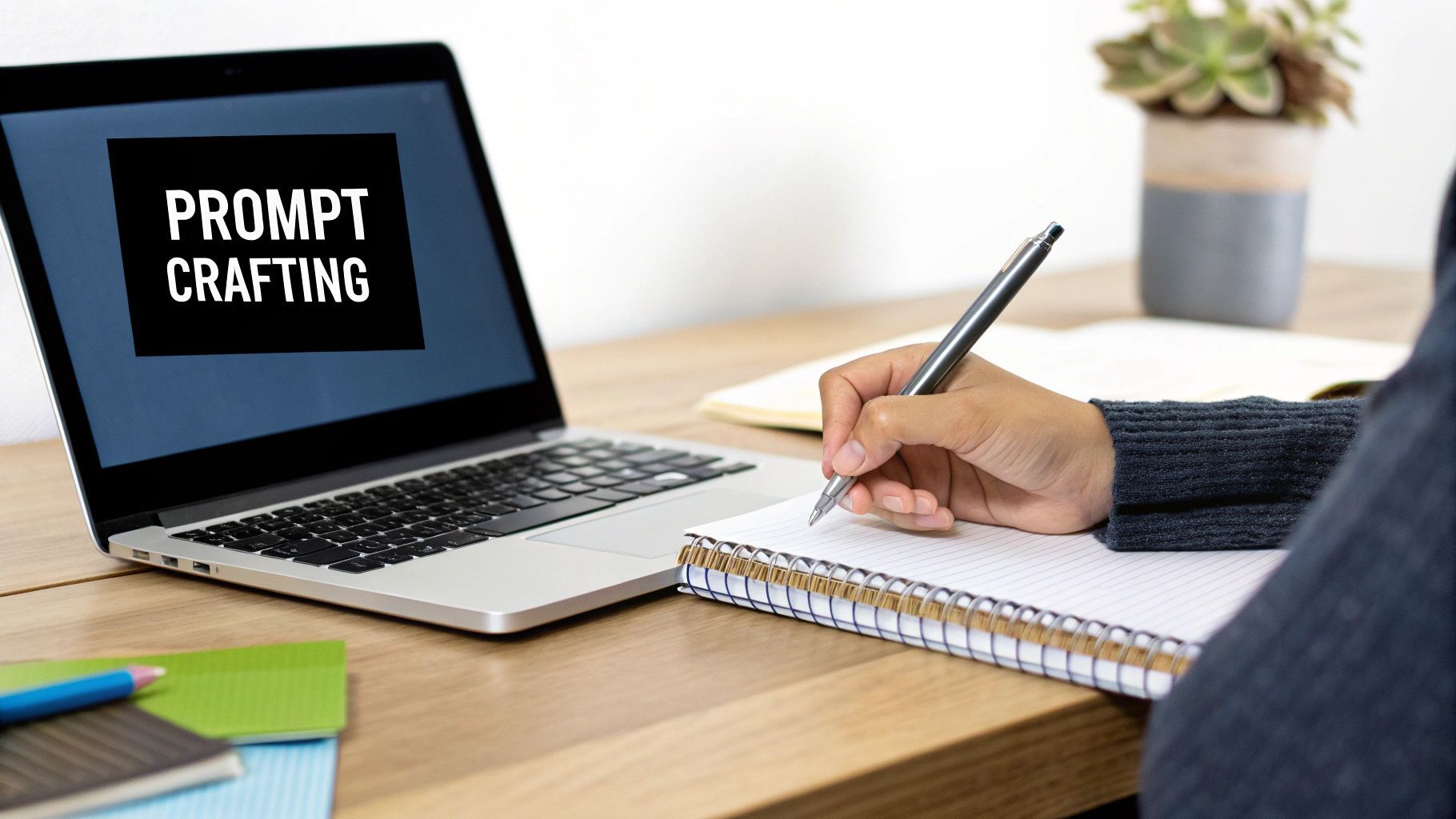
Think of these advanced features less like a command line and more like a creative partnership. You're no longer just shouting orders from the director's chair; you're handing the AI a visual blueprint and working together. It’s an incredible way to fuse your own vision with the AI’s massive processing power.
One of the most powerful tools in your new arsenal is image-to-image generation. Forget starting with a blank slate. Instead, you upload your own image to act as a foundation. This could be anything—a quick doodle on a napkin, a stock photo you like, or even a previous AI image you want to take in a new direction.
The AI then uses your upload as a heavy-duty reference for the composition, colors, and overall vibe. Then, it re-imagines the whole thing based on your new text prompt. This technique is an absolute game-changer.
Breathe Life into Your Sketches: Got a cool concept scribbled in a notebook? Snap a photo, upload it, and prompt the AI to "turn this sketch into a photorealistic oil painting." Prepare to be amazed as your rough drawing gets a serious glow-up. Remix and Restyle Photos: Grab a standard product shot and ask the AI to transport it somewhere new, like "a sun-drenched beach at golden hour" or "a futuristic neon-lit city." Instant vibe change. Iterate on Your Wins: Love an image you made but wonder what it would look like in a different medium? Upload it and prompt "in the style of a vintage comic book" to get a fresh take while keeping the composition you already nailed.
You know that feeling when you generate an almost perfect image, but one tiny detail is driving you crazy? Maybe the character has a weird expression, or there's a random lamp in the background. This is what inpainting was made for. It’s like having a magic eraser and a Photoshop brush rolled into one.
You just mask over the part you want to fix and tell the AI what should be there instead. For example, you could highlight a character's boring shirt and prompt "a blue shirt with a dragon logo" to seamlessly swap it out without having to re-roll the entire image.
Outpainting, on the other hand, is your solution when the canvas feels too cramped. It lets you literally expand the borders of your image, and the AI intelligently fills in the new space. Want to zoom out on a portrait and see the rest of the room? Outpainting can generate the rest of the scene, creating a wider, more complete picture that looks totally natural.
These tools shift your role from director to hands-on editor. Inpainting and outpainting give you pixel-level control, letting you fix nagging flaws and expand your creative vision far beyond the initial frame.
One of the biggest headaches when making a series or telling a story is getting your characters to look the same from one image to the next. Left to its own devices, the AI will create a slightly different person every single time. This is where seed numbers become your secret weapon.
Think of a seed number as the unique DNA for a specific generation. By using the exact same seed number with a similar prompt, you can produce images with uncanny consistency.
For example, once you generate a character you absolutely love, grab that seed number. For your next image, use that same seed but just tweak the action or setting in the prompt. Change "a female knight standing in a castle" to "a female knight fighting a dragon," and you'll find her face, armor, and style stay remarkably similar. This is the key to creating a believable cast for your visual stories. For more in-depth strategies, our guide on how to use an AI image generator has you covered.
Alright, let's talk business. Because as fun as it is to create wild, imaginative art, the real magic happens when you turn those AI-generated images into cold, hard cash. This isn't just a creative toy; it's a powerful tool that's already changing how companies work, saving them a fortune, and unlocking entirely new ways to make money.
And this isn't some niche trend. The AI image generator market was already valued at a massive USD 9.1 billion and is on a rocket ship trajectory to hit around USD 63.3 billion by 2030. That explosion is happening because businesses in e-commerce, marketing, and practically every other industry are jumping in. You can get the full scoop on the AI image generator market to see just how big this wave is.
Kiss those expensive stock photo subscriptions goodbye. You know the ones—filled with cheesy, generic visuals that scream "I was made for a corporate PowerPoint in 2012." With AI, you can conjure a near-infinite supply of unique, on-brand images for every single ad, post, or email campaign.
Let’s say you run a small coffee shop. Instead of that same old stock photo of a latte, you could prompt something like: "A cozy, sunlit coffee shop corner in autumn, steaming latte with intricate foam art on a rustic wooden table, photorealistic." In seconds, you have a perfect, royalty-free image that feels uniquely yours.
Here’s where marketers are cleaning up:
Ad Creatives: Need to A/B test ad visuals? Generate a dozen variations in minutes, not days. Social Media Content: Create thumb-stopping graphics for Instagram, Facebook, and X that actually grab attention. Blog Headers: Instantly whip up custom headers and featured images that perfectly match what you’re writing about.
For any online store, professional product photography is a huge budget-killer. AI image generation completely flips the script. Businesses are now creating slick, professional product mockups and lifestyle shots without ever stepping foot in a studio.
Imagine a new skincare startup. They can take one clean photo of their product and use AI to place it anywhere. Picture their bottle on a chic marble countertop, next to a misty waterfall, or held by models of every ethnicity and age group. All this is possible from a single image and a few smart prompts.
The ROI here is just a no-brainer. You're slashing photography costs, getting products to market faster, and gaining the incredible freedom to create new visuals for sales, seasons, and promotions whenever you want.
If you're a blogger, YouTuber, or any kind of content creator, you know that visuals are half the battle. Think of AI as your personal, on-demand illustrator, ready to create amazing custom art that fits your brand perfectly.
Need a YouTube thumbnail that practically begs to be clicked? Or maybe a set of whimsical illustrations for that children's book you're finally writing? Done and done. We've even seen musicians use SendFame to create incredible visuals for their music, building a whole aesthetic from scratch. Check out our deep dive into creating AI-generated album covers to see just how cool it can get.
And if you're thinking about merch, AI is your new best friend. You can design absolutely one-of-a-kind graphics for t-shirts, mugs, or posters. Once you've nailed a design, you can use a comprehensive guide to custom t-shirt printing to turn that digital idea into a real, physical product. That's a straight line from a simple text prompt right into your customers' hands.
Jumping into AI image creation is an absolute blast, but it's totally normal to have a few questions bubble up as you get started. Think of this as your personal cheat sheet for the most common head-scratchers. We'll get them sorted so you can get back to creating awesome visuals.
Let's dive right into the big ones.
This is the big one, right? The short answer is almost always yes. The nitty-gritty details, however, really come down to the terms of service of the AI tool you're using.
Most modern platforms, SendFame included, are built with creators and businesses in mind. They typically grant you full commercial rights to whatever you cook up. That means you're good to go for marketing campaigns, website headers, social media, or even printing your designs on a t-shirt to sell.
Just keep in mind, the legal world is still catching up to AI copyright. It's always a good idea to spend two minutes glancing over the specific policy of any tool you use. But for the vast majority of business and personal projects, you’re in the clear.
Ah, the quest for consistency! It’s the key to a professional-looking brand. The secret isn't just luck; it's about crafting a repeatable "style prompt."
This isn't just a single word. It’s a little cocktail of key phrases that locks in your specific look, feel, color scheme, and mood.
Example Style Prompt: minimalist line art, pastel color palette, soft shadows, clean background, serene mood
Just tack this little recipe onto the end of your main subject prompt. Over time, you're essentially teaching the AI what your brand's visual DNA looks like. Another killer trick is to reuse the "seed number" from an image you absolutely love. This tells the AI to use the same starting point, giving you new variations that feel closely related.
A consistent look isn't random. It's about having a solid recipe. Your style prompt is that recipe, and the seed number is the secret sauce that guarantees similar results every single time.
Hands down, the biggest mistake is being too vague. A prompt like "a car" is a one-way ticket to a boring, generic image. The AI has nothing to work with, so it just spits out the most painfully average car it can think of. You've got to give it some flavor!
Another classic blunder is using conflicting ideas. Throwing in phrases like "a bright midnight" or "a simple but intricate design" just scrambles the AI's circuits. It takes your words very literally, so you'll end up with some pretty strange results. If you want to get into the weeds on this, you can learn more about how these models understand language by checking out our guide on what is synthetic media.
Finally, try to avoid writing a novel in the prompt box. A clean series of descriptive keywords and short phrases, separated by commas, works way better. This format is much easier for the AI to chew on, letting it apply each part of your instruction with more precision.
Ready to stop wondering and start creating? With SendFame, you can generate stunning, unique visuals for any project in seconds. Turn your wildest ideas into reality today. Get started with SendFame now!
Create Epic
SendFame